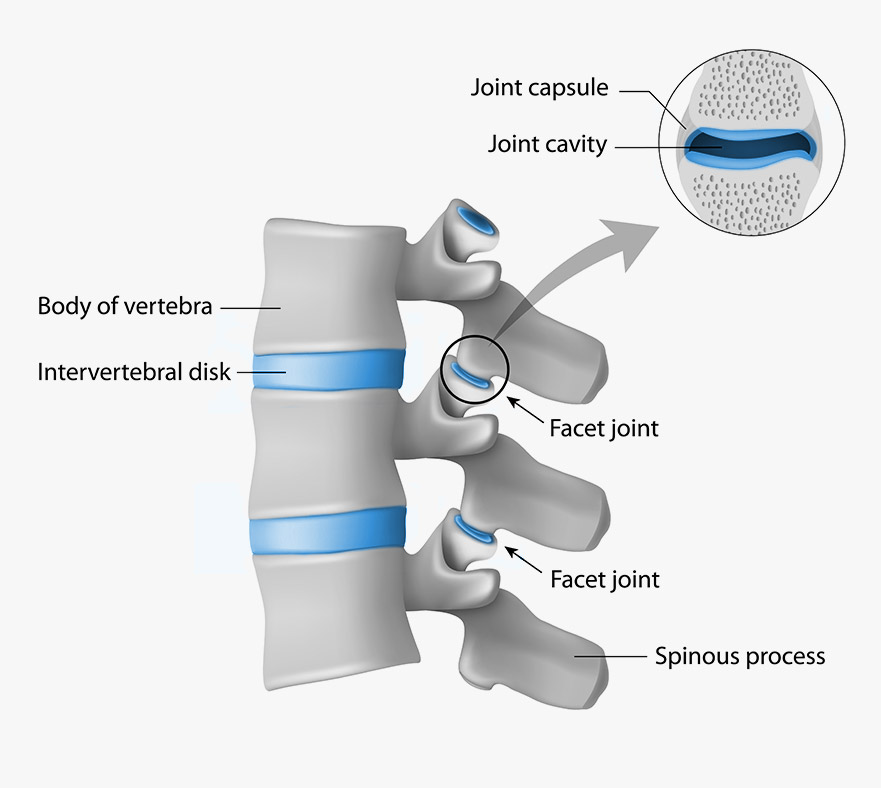Facet Joint Injections and Medial Branch Blocks
What are the facet joints and medial branch nerves?
Facet joints are located in your neck and back and are small joints that in pairs connect the bones in your spine together, they provide stability and allow the spine to bend and twist.
The medial branch nerves are small nerves that are connected to the facet joint and carry pain signals from these joints to the brain.
Facet joint injections are injections of local anaesthetic (this helps to numb the pain) and steroid (helping to reduce inflammation) which are injected directly into the joint space.
A medial branch block is a similar procedure, targeting the nerves (medial branches) that connect the facet joints to the brain, sending pain signals.

The injection of anaesthetic and steroid is intended to temporarily stop these pain signals.
Both these procedures are used to gage whether your pain is being caused by your facet joints. If the injections help to alleviate your pain then it demonstrates that your facet joints are the cause. The result 9whether positive or negative) can then be used to determine future treatment options.
If a medial branch block is successful in significantly reducing pain, a procedure called Facet Joint Rhizolysis (please see link) can be a longer term treatment option and may be funded by the NHS.
Successful facet joint injections or medial branch blocks can help reduce pain to allow you to undertake physiotherapy/ rehabilitation more successfully.
What happens before the procedure?
Before being referred for either a facet joint injection or medial branch block you will need to be assessed by a specialist surgeon or practitioner who will take a full history of your symptoms and perform a thorough physical examination. They may need to send you for some imaging of the affected area of your spine such as an X-ray, CT or MRI scan that can be used to determine the underlying cause of your back pain, for example osteoarthritis (degenerative changes).
How do I prepare for my procedure?
Please inform us if you take a blood thinning medication when you arrange your appointment as some need to be temporarily withheld beforehand. Common blood thinning medications include antiplatelets (aspirin or clopidogrel) and anticoagulants (warfarin, apixaban, dabigatran, or rivaroxaban).
Do not stop any medication before talking to us.
Diabetics should closely monitor their blood sugar level before and after the procedure as the steroid medication in the injection can affect this for several days.
You will need to arrange for someone to bring to you to the hospital and to drive you home after the procedure. Ideally you should have someone stay with you for 24 hours after your appointment.
You should not drive for 24 hours following the procedure.
What happens during the procedure?
Facet joint injections and medial branch blocks are performed in the hospital as an outpatient under local anaesthetic and you will go home the same day.
You will not require sedation or general anaesthetic.
An experienced specialist Doctor (Radiologist) will carry out the procedure in a room with a special X-ray camera, called fluoroscopy. The injections only take a short time but the whole procedure may take up to 30 minutes.
You will be asked to lie on your front for the procedure, we will aim to make you as comfortable as possible. The doctor will then clean the skin on your neck/back with antiseptic and cover with sterile drapes.
The skin of the affected area of the neck/back will be injected with local anesthetic to numb any pain. The doctor will then guide the needle to the correct position with the help of live X-ray images. Once in position, the doctor will inject the mix of local anesthetic and steroid into the joint or in the case of a medial branch block the injection will be into the nerves in your facet joints. The needle will then be removed.
This process may then be repeated, depending on how many joints are being treated during the procedure.
You will usually be able to go home half an hour after the procedure is finished.
What are the side effects of the procedure?
The most common side effect of the injections are slight tenderness and/or bruising at the site of the injection, this usually resolves over the first few days.
In some cases people may feel increased pain for a few days after the injection but this should settle.
More serious side effects are rare but can include bleeding, infection, nerve injury and allergic reactions to the medications used in the procedure.
It is important to seek medical help if you are feeling unwell.
How will I feel after the injection?
You may experience an immediate improvement in symptoms from the injection of local anaesthetic. This effect usually lasts for 12-24 hours.
The steroid medication usually takes two to three days to have an effect and typically peaks at one-two weeks.
Regular pain relief medication can be continued as required.
The success of the injections in reducing a person’s pain and for what length of time varies with the individual.

